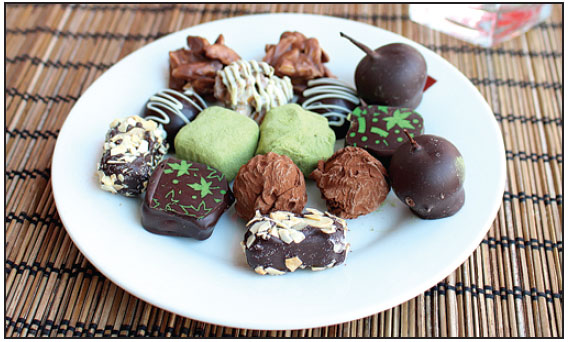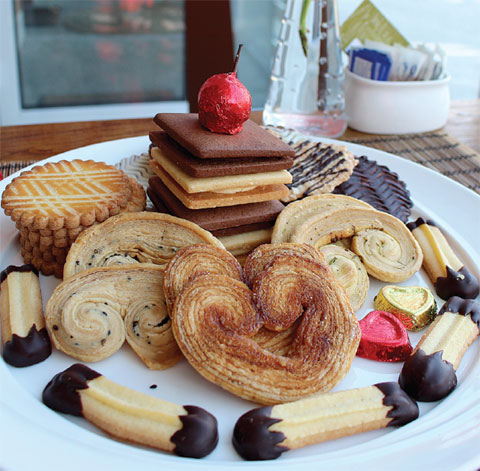Eat your heart out
Updated: 2015-02-12 07:50
By Liu Zhihua(China Daily)
|
|||||||||||
For a Japanese chocolate-maker, Valentine's Day may be the most wonderful time of the year. Sugita Tsyguo tells Liu Zhihua about making life sweet in China's capital.
The small cubes of ganache are black and rich, and melt with the sweetness of Belgian dark chocolate, German cream and rum. A light dusting of cocoa powder adds an echo of bitterness.
"It's a perfect Valentine - bittersweet, maybe like love itself," says Sugita Tsyguo, a Japanese chocolate master who has settled in a Beijing suburb to bring his culinary arts to the capital.
No one in China is more prepared than Sugita for Feb 14, when lovers who seek sweet somethings for their enamorata come looking for the perfect taste of love: chocolate.
His handmade candies gleam in the chilled glass cases of Aux Delices, enticing locals from the nearby expat community of Shunyi.
But the business doesn't depend on appreciation by foreigners. A growing number of Chinese have become fans since the 70-year-old chef teamed up with Beijing interior designer Lillian Tian to found the chocolate and cake shop. Aux Delices also caters events for companies downtown.
Sugita always uses imported materials to craft his handmade artisan chocolates and cakes, including South Korean granulated sugar, Belgian chocolate cocoa beans, French cream and Japanese wheat powder.
The shop's signature product is orange-peel chocolate, dark Belgian chocolate with sugar-pickled orange peels inside. The fingerlike candies taste soft, smooth and sweet at first bite, and then the citrus flavor of the crunchy peels inside the rich candy brings a fresh sensation to the taste buds.
Orange peels not only taste good, Sugita says, but also are beneficial to health.
Practitioners of traditional Chinese medicine uses them to treat coughs and digestive-tract discomforts. The peels are pickled in sugar for hours, following a secret formula Sugita modified from a French recipe.
Sugita was born in Japan's Shizuoka prefecture in 1945, and became fascinated with chocolate as a child.
"I got my first chocolate from an American soldier stationed in Japan after World War II - a Hershey bar!" he recalls with a grin.
In 1969, he went to France and spent a year as an apprentice at an artisan chocolate shop. Then he moved on to Switzerland to learn more about making chocolate by hand in a vocational school. At age 30, he returned to his home country, and started Aux Delices, a handmade chocolate-shop chain.
Business was bad at the beginning because eating handmade chocolate wasn't familiar to Japanese people, who were more familiar with mass-produced products such as Hershey bars.
But starting in the late 1970s, as more Japanese people fell in love with the taste and health benefits of handmade chocolate, he says, the company's business has continued prospering. It has also begun to sell imported raw chocolate-making materials.
In 2005, he came to China for the first time, creating handmade chocolate for cafes in Kunming and Dali in Yunnan province.
"Handmade chocolates are very healthy, because they have few chemical additives. I love them and eat them every day," says the chef, who remains fit and trim.
"But just like Japanese people used to be, most Chinese know little about handmade chocolate, and have had little access to this food."
Sugita says he came to Beijing because he believes people in the capital are more open-minded.
The shop's chocolates hit the palate with an initial sweetness, becoming complex as the taste buds pick up a hint of bitterness. They are most delicious when eaten slightly chilled, the chef suggests, though one popular confection, the chocolate truffles, are best at room temperature.
The truffles are shaped into small irregular mounds that resemble mushrooms. The texture and taste changes from a crumbly outside coating to a gooey center (made with an expensive brandy).
Unlike machine-made chocolates, the handmade creations have only three ingredients: ground cocoa beans, sugar and lecithin, which acts as an emulsifier. Mass-produced chocolates are often "enhanced" with other ingredients to boost preservation and flavor, including milk, oils, fats and chemical additives, according to Sugita.
An orange-peel chocolate in the shop costs 10 yuan ($1.60), and the truffles also cost 10 yuan each. Raw chocolate costs 48 yuan for an 80-gram package.
Through Feb 15, customers will get a tiny pair of chocolate high-heel shoes at the shop to celebrate Valentine's Day.
Contact the writer at liuzhihua@chinadaily.com.cn
Mike Peters contributed to this story.
|
Top and below: Japanese chocolatemaster Sugita Tsyguo's handmade artisan chocolates and cakes. Photos Provided To China Daily |


(China Daily 02/12/2015 page24)
Today's Top News
Russia's YotaPhone places big bet on China
EU leaders to urge stricter border checks in counter-terror drive
Leaders hold Ukraine peace talks as fighting surges
Costa Concordia captain sentenced to 16 years for 2012 shipwreck
Chinese investors shifting focus in global realty purchases
Greek PM easily wins confidence vote
Contact group on Ukraine reaches ceasefire deal
China should be alert to deflation risks
Hot Topics
Lunar probe , China growth forecasts, Emission rules get tougher, China seen through 'colored lens', International board,
Editor's Picks

|

|

|

|

|

|






